New Calibrator with Points Distributed Conical Helically for Online Calibration of C-Arm
Abstract
:1. Introduction
2. Online C-Arm Calibration Method for Surgery Navigation System
2.1. Image Distortion Correction
2.2. Pinhole Model
2.3. Design of Online C-Arm Calibrator
2.3.1. Conical Spiral Curve Model for C-arm Calibration
2.3.2. Definitions of Errors of Point Matching Spatial Registration
2.3.3. Relationship between Fiducial Points and Registration Errors
2.3.4. Design of Online C-arm Calibrator
3. Experiments and Results
3.1. Experiment of Rectification Error
3.2. Experiment of Calibration Accuracy
3.3. Navigation and Positioning System for ACL Reconstruction
4. Discussion and Conclusions
Author Contributions
Funding
Acknowledgments
Conflicts of Interest
References
- Wolf, A.; Digioia, A.M.; Jaramaz, B.; Mor, A.B.; Scuderi, G.R.; Berger, R.A. Computer-guided total knee arthroplasty. In MIS Techniques in Orthopedics; Scuderi, G.R., Tria, A.J., Berger, R.A., Eds.; Springer-Verlag: New York, NY, USA, 2005; pp. 390–407. [Google Scholar]
- Parkinson, B.; Robb, C.; Thomas, M.; Thompson, P.; Spalding, T. Factors That Predict Failure in Anatomic Single—Bundle Anterior Cruciate Ligament Reconstruction. Am. J. Sports Med. 2017, 45, 1529–1536. [Google Scholar] [CrossRef] [PubMed]
- Achtnich, A.; Ranuccio, F.; Willinger, L.; Pogorzelski, J.; Imhoff, A.B.; Braun, S.; Herbst, E. High incidence of partially anatomic tunnel placement in primary single-bundle ACL reconstruction. Knee Surg. Sports Traumatol. Arthrosc. 2017, 26, 1–6. [Google Scholar] [CrossRef]
- Lubowitz, J.H. All-inside ACL: Reconstruction controversies. Sports Med. Arhtrosc. Rev. 2010, 18, 20–26. [Google Scholar] [CrossRef]
- Mochizuki, T.; Muneta, T.; Nagase, T.; Shirasawa, S.; Akita, K.I.; Sekiya, I. Cadaveric knee observation study for describing anatomic femoral tunnel placement for two-bundle anterior cruciate ligament reconstruction. Arthroscopy 2006, 22, 356–361. [Google Scholar] [CrossRef] [PubMed]
- Yu, Z.; Wang, L. Research status of navigation system for orthopedic surgery. Foreign Med. Sci.·Sect. Orthop. 2005, 26, 140–144. [Google Scholar]
- Foley, K.T.; Simon, D.A.; Rampersaud, R. Virtual fluoroscopy. Oper. Tech. Orthop. 2000, 10, 77–81. [Google Scholar] [CrossRef]
- Tomaževič, D.; Likar, B.; Slivnik, T.; Pernus, F. 3-D/2-D registration of CT and MR to X-ray images. IEEE Trans. Med. Imaging 2003, 22, 1407–1416. [Google Scholar] [CrossRef]
- Wang, T.; Liu, W.; Hu, L.; Sun, L.; Zhang, L. Polynomial fitting-based global correction method for C-arm projection images. Chin. High Technol. Lett. 2007, 17, 919–923. [Google Scholar]
- Sheng, L. Registration Theory and Methods for Robot-assisted Minimal Invasive Orthopaedic Surgery. Ph.D. Thesis, Beihang University, Beijing, China, 2010. [Google Scholar]
- Taylor, R.H.; Stoianovici, D. Medical robotics in computer-integrated surgery. IEEE Trans. Robot. Autom. 2003, 19, 765–781. [Google Scholar] [CrossRef]
- Cerveri, P.; Forlani, C.; Borghese, N.A.; Ferrigno, G. Distortion correction for x-ray image intensifiers: Local unwarping polynomials and RBF neural networks. Med. Phys. 2002, 29, 1759–1771. [Google Scholar] [CrossRef]
- Forlani, C.; Ferrigno, G. Automatic Real-Time XRII Local Distortion Correction Method for Digital Linear Tomography. In Proceedings of the Computational Science—ICCS 2001, San Francisco, CA, USA, 28–30 May 2001; pp. 23–26. [Google Scholar]
- Gronenschild, E. The accuracy and reproducibility of a global method to correct for geometric image distortion in the x-ray imaging chain. Med. Phys. 1997, 24, 1875. [Google Scholar] [CrossRef]
- Zhou, X. Study on Image Correction & Location Technique of C-arm. Master’s Thesis, Beijing University of Posts and Telecommunications, Beijing, China, 2010. [Google Scholar]
- Miao, W.; Yang, S.; Zhang, F. The design and experimental research of navigation system based on C-arm. In Proceedings of the IEEE International Conference on Cyborg and Bionic Systems, Shenzhen, China, 25–27 October 2018; pp. 77–82. [Google Scholar]
- Zhang, J.; Zhang, F.; Sun, L.; Kuang, S. Camera calibration method of surgical navigation based on C-arm. J. Comput. Appl. 2016, 36, 2327–2331. [Google Scholar]
- Livyatan, H.; Yaniv, Z.; Joskowicz, L. Robust Automatic C-Arm Calibration for Fluoroscopy-Based Navigation: A Practical Approach. In Medical Image Computing and Computer-Assisted Intervention—MICCAI 2002; Springer: Berlin/Heidelberg, Germany, 2002; pp. 60–68. [Google Scholar]
- Cai, M.; Zhang, J.; Zhou, F.; Wang, T. New method for geometric calibration and distortion correction of conventional C-arm. Comput. Biol. Med. 2014, 52, 49–56. [Google Scholar]
- Vachon, É.; Miró, J.; Duong, L. Online C-arm calibration using a marked guide wire for 3D reconstruction of pulmonary arteries. Proc. SPIE 2017, 2017, 101351V. [Google Scholar]
- Thürauf, S.; Wolf, M.; Körner, M.; Vogt, F.; Hornung, O.; Ali Nasseri, M.; Knoll, A. A realistic X-ray simulation for C-arm geometry calibration. In Proceedings of the IEEE International Conference on Biomedical Robotics and Biomechatronics, Singapore, 26–29 June 2016. [Google Scholar]
- Chung, K.; Schad, L.R.; Zöllner, F.G. Tomosynthesis implementation with adaptive online calibration on clinical C-arm systems. Int. J. Comput. Assist. Radiol. Surg. 2018, 6, 1–15. [Google Scholar]
- Chang, C.J.; Lin, G.L.; Tse, A.; Chu, H.Y.; Tseng, C.S. Registration of 2D C-Arm and 3D CT Images for a C-Arm Image-Assisted Navigation System for Spinal Surgery. Appl. Bionics Biomech. 2015, 2015, 478062. [Google Scholar] [CrossRef] [PubMed]
- Matthews, F.; Hoigne, D.J.; Weiser, M.; Wanner, G.A.; Regazzoni, P.; Suhm, N.; Messmer, P. Navigating the fluoroscope’s C-arm back into position: An accurate and practicable solution to cut radiation and optimize intraoperative workflow. J. Orthop. Trauma 2007, 21, 687–692. [Google Scholar] [CrossRef]
- Wiles, A.D.; Likholyot, A.; Frantz, D.D.; Peters, T.M. A statistical model for point-based target registration error with anisotropic fiducial localizer error. IEEE Trans. Med. Imaging 2008, 27, 378–390. [Google Scholar] [CrossRef] [PubMed]
- Telea, A. An Image Inpainting Technique Based on the Fast Marching Method. J. Graph. Tools 2004, 9, 23–34. [Google Scholar] [CrossRef] [Green Version]
- Pannao, W.; Pintavirooj, C. Application of direct linear transform for calibration of miniature computed tomography. In Proceedings of the 5th 2012 Biomedical Engineering International Conference, Ubon Ratchathani, Thailand, 5–7 December 2012. [Google Scholar]
- Wang, M. Research on the Relationship of Three Kinds of Errors in Point Matching Spatial Registration. J. Tissue Eng. Reconstr. Surg. 2014, 1, 4–7. [Google Scholar]
- Shu, Z.; Qi, F. A Novel Algorithm for Fast Circle Detection Using Randomized Hough Transform. Comput. Eng. 2003, 6, 87–88. [Google Scholar]
- Maurer, C.R.; Fitzpatrick, J.M.; Wang, M.Y.; Galloway, R.L.; Maciunas, R.J.; Allen, G.S. Registration of head volume images using implantable fiducial markers. IEEE Trans. Med. Imaging 1997, 16, 447–462. [Google Scholar] [CrossRef] [PubMed]
- Hamming, N.M.; Daly, M.J.; Irish, J.C.; Siewerdsen, J.H. Automatic image-to-world registration based on x-ray projections in cone-beam CT-guided interventions. Med. Phys. 2009, 36, 1800–1812. [Google Scholar] [CrossRef] [PubMed] [Green Version]
- Wang, M. Analysis of the Errors in Neuro-Navigation and Research on Improving the Accuracy of Space Registration. Ph.D. Thesis, Fudan University, Shanghai, China, 2010. [Google Scholar]
- Chen, L.; Armstrong, C.W.; Raftopoulos, D.D. An investigation on the accuracy of three-dimensional space reconstruction using the direct linear transformation technique. J. Biomech. 1994, 27, 493–500. [Google Scholar] [CrossRef]
- Luo, C. Point Spatial Analysis- fractal dimension and uniform index. Sci. Technol. Rev. 2004, 22, 51–54. [Google Scholar]
- Liu, Y.; Zhang, Z.; Ma, E. Some Methods of Measuring the Uniform Character of Finite Point Sets. J. Cap. Norm. Univ. (Nat. Sci. Ed.) 1997, 12–16. [Google Scholar]
- Bird, J.H.; Carmont, M.R.; Dhillon, M.; Smith, N.; Brown, C.; Thompson, P.; Spalding, T. Validation of a New Technique to Determine Midbundle Femoral Tunnel Position in Anterior Cruciate Ligament Reconstruction Using 3-Dimensional Computed Tomography Analysis. Arthroscopy 2011, 27, 1259–1267. [Google Scholar] [CrossRef]


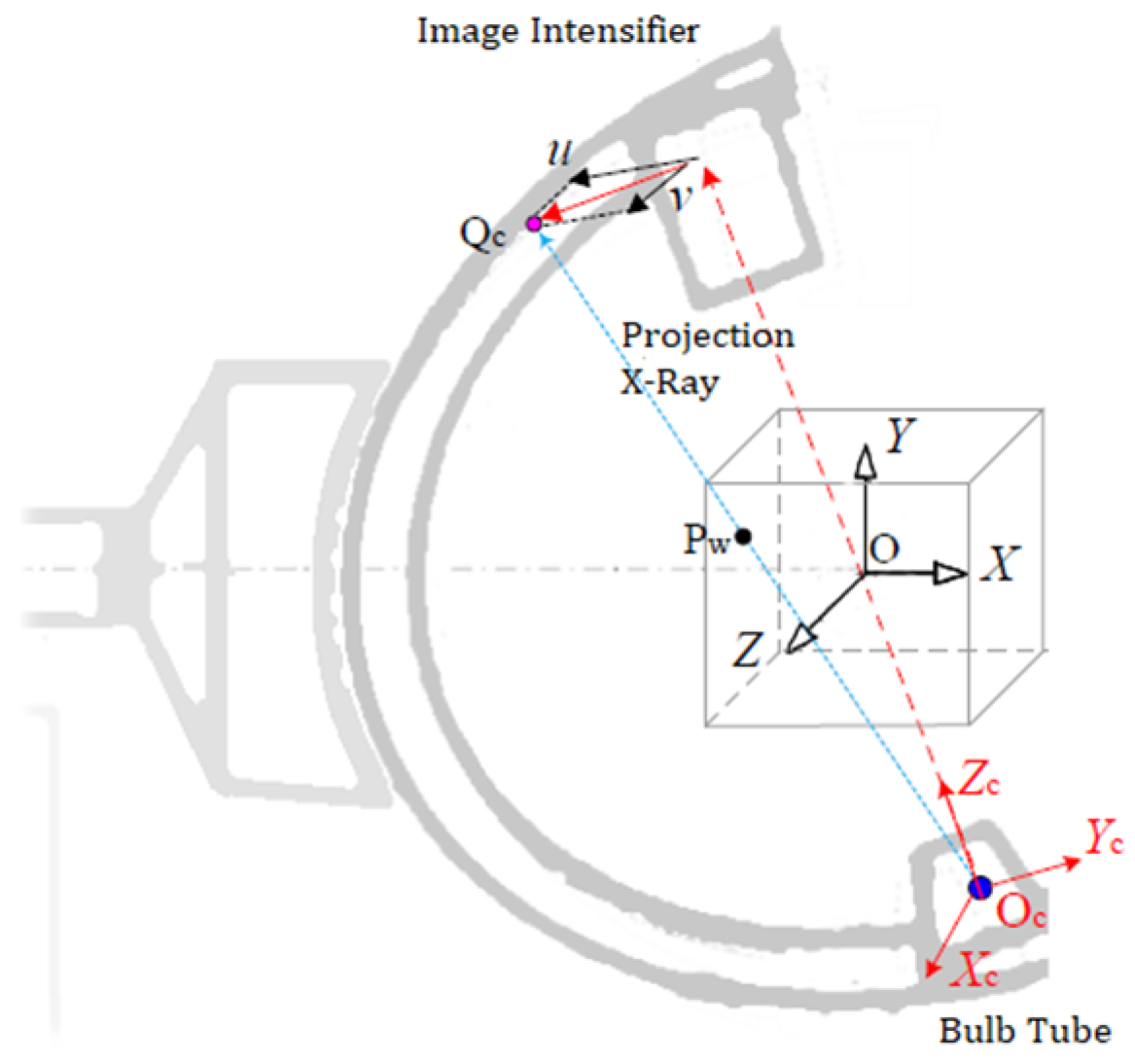


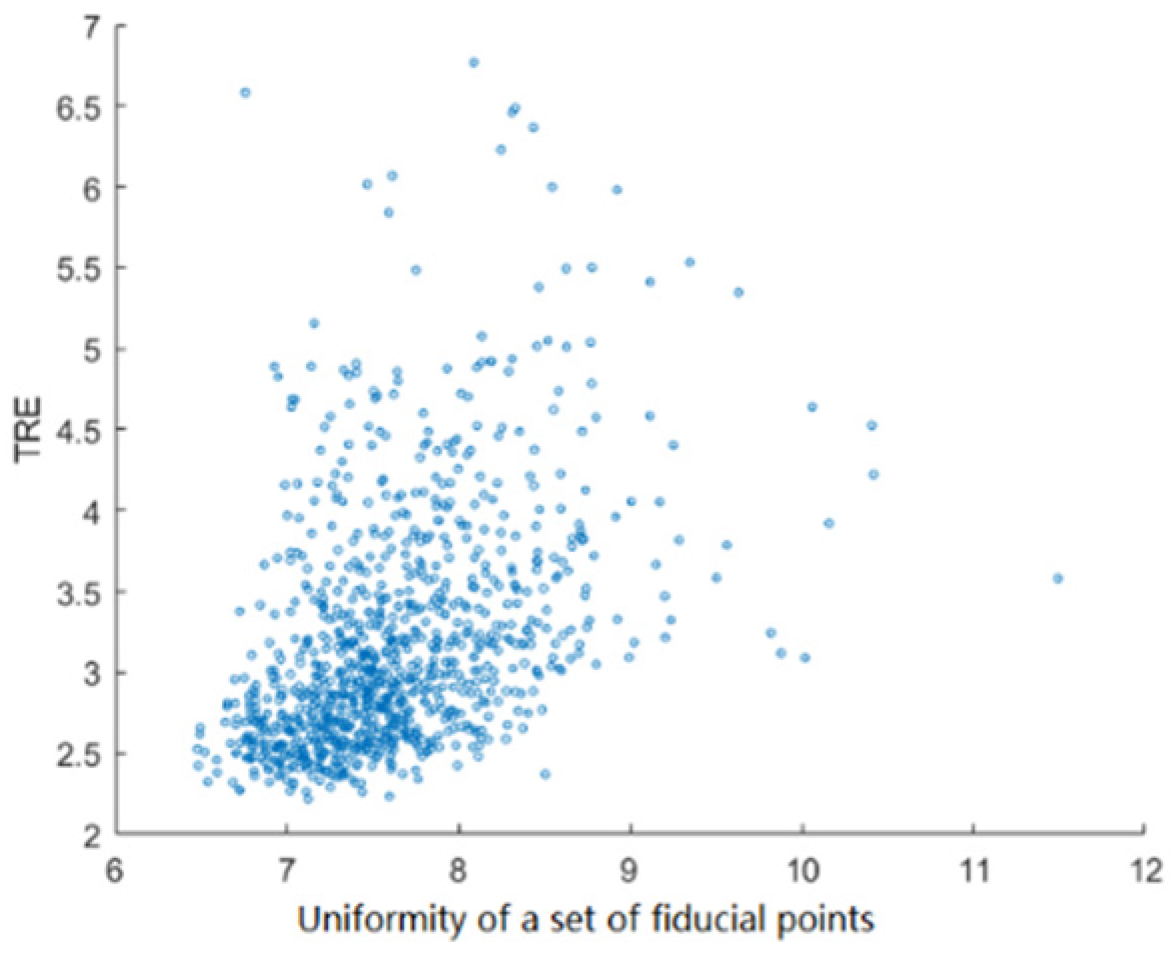


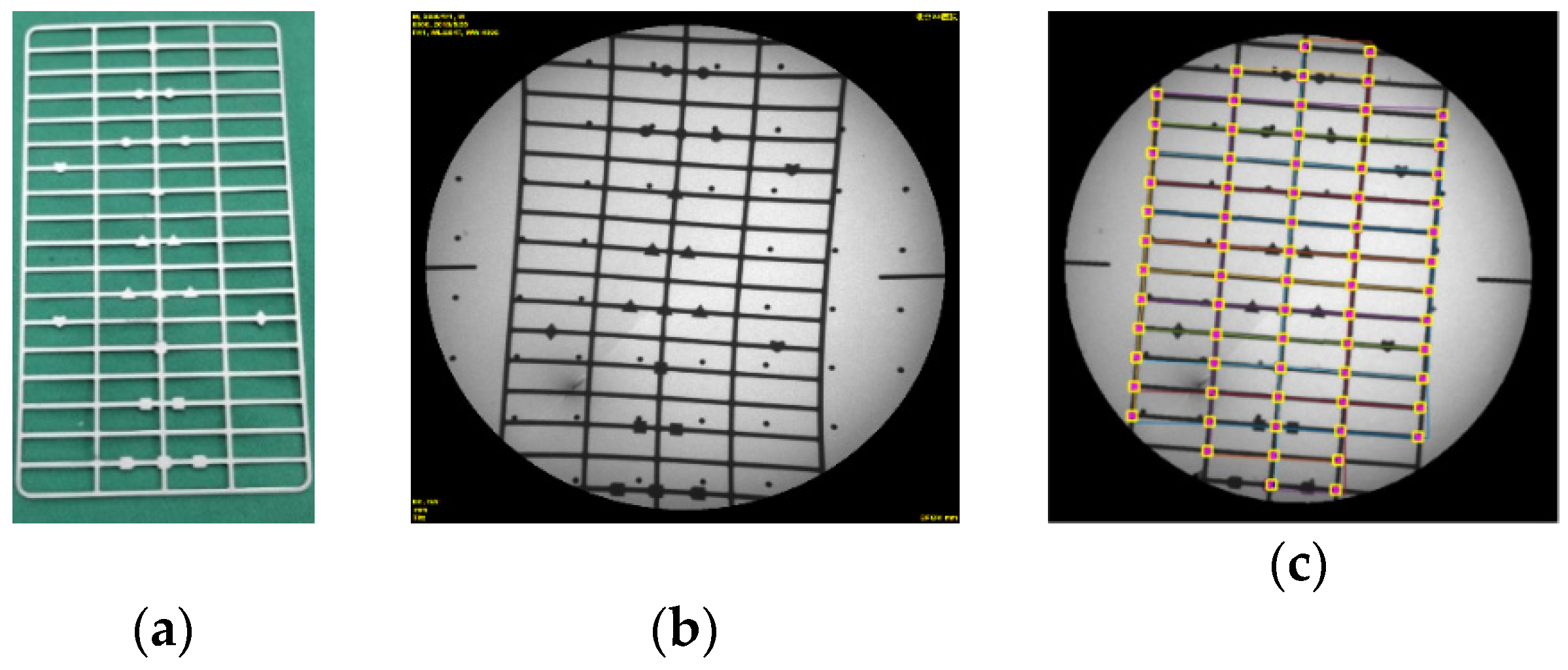
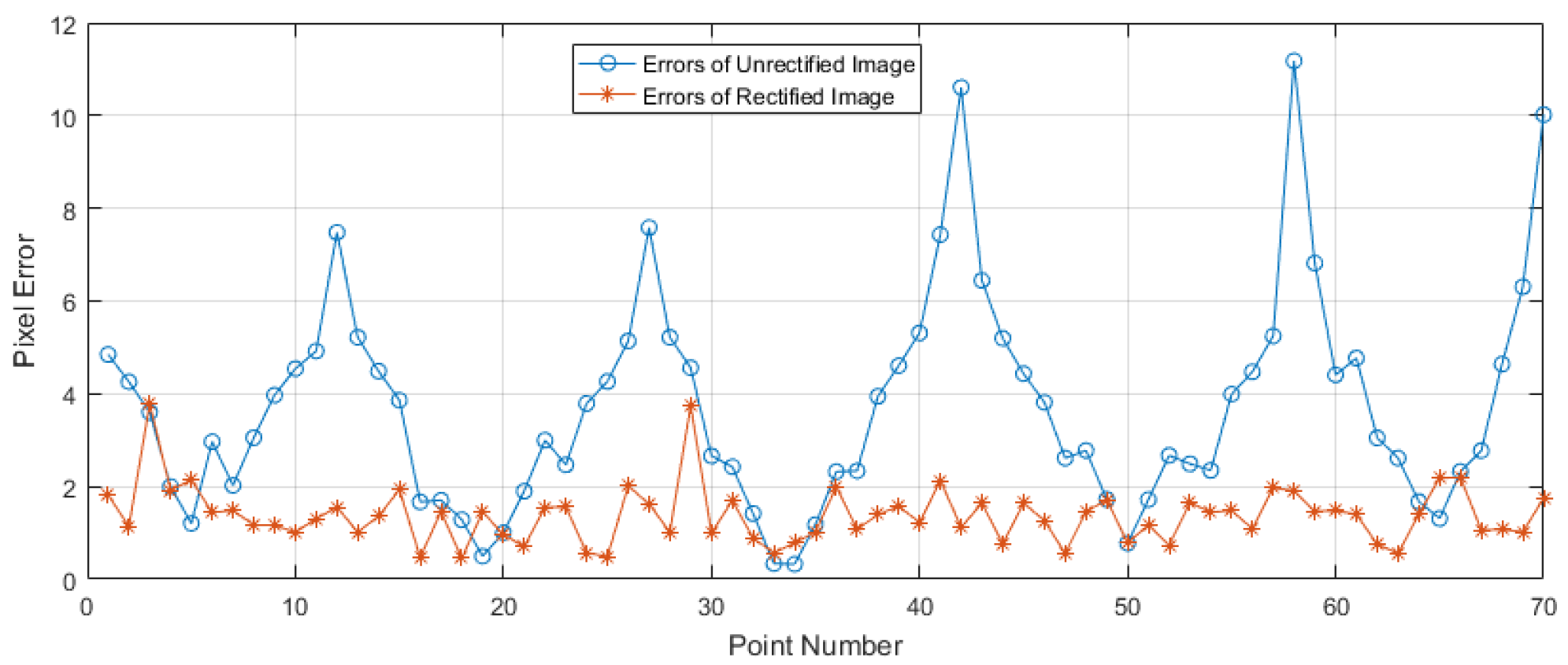
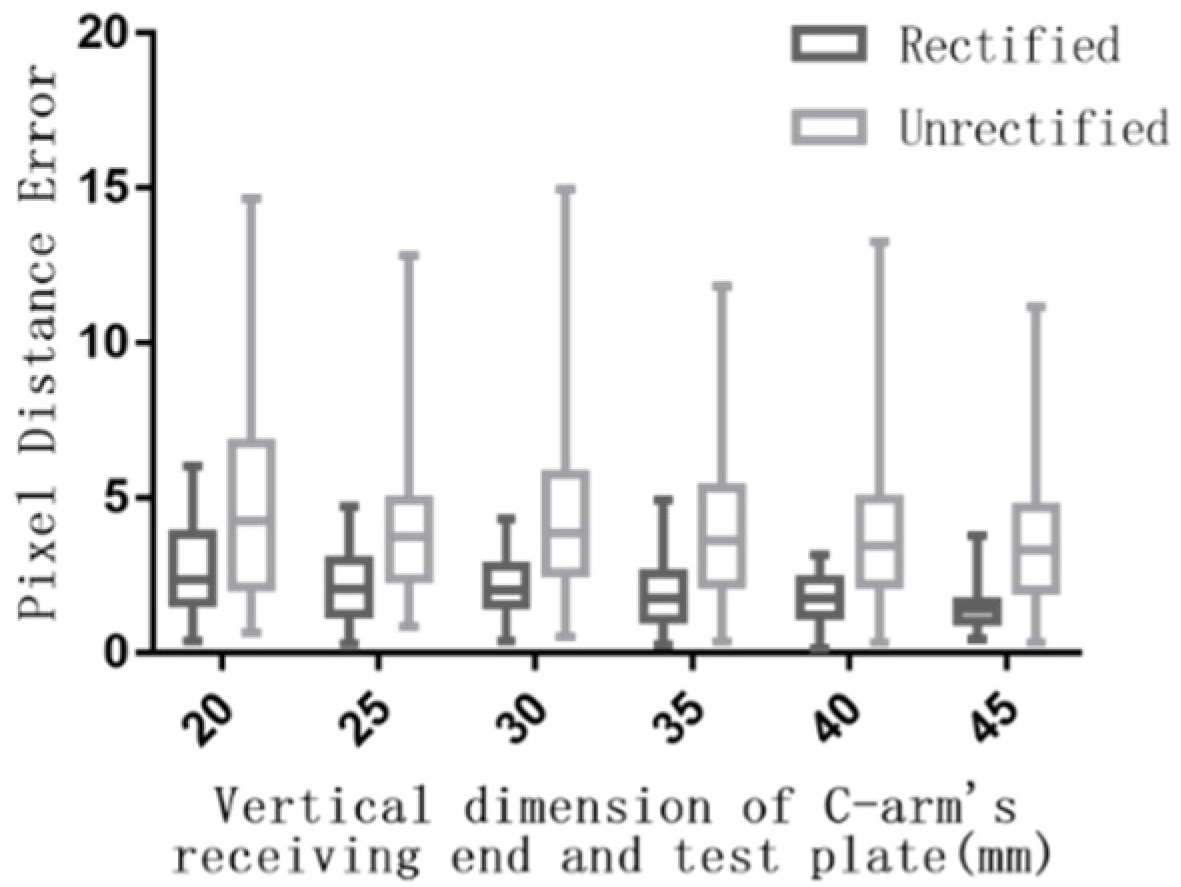
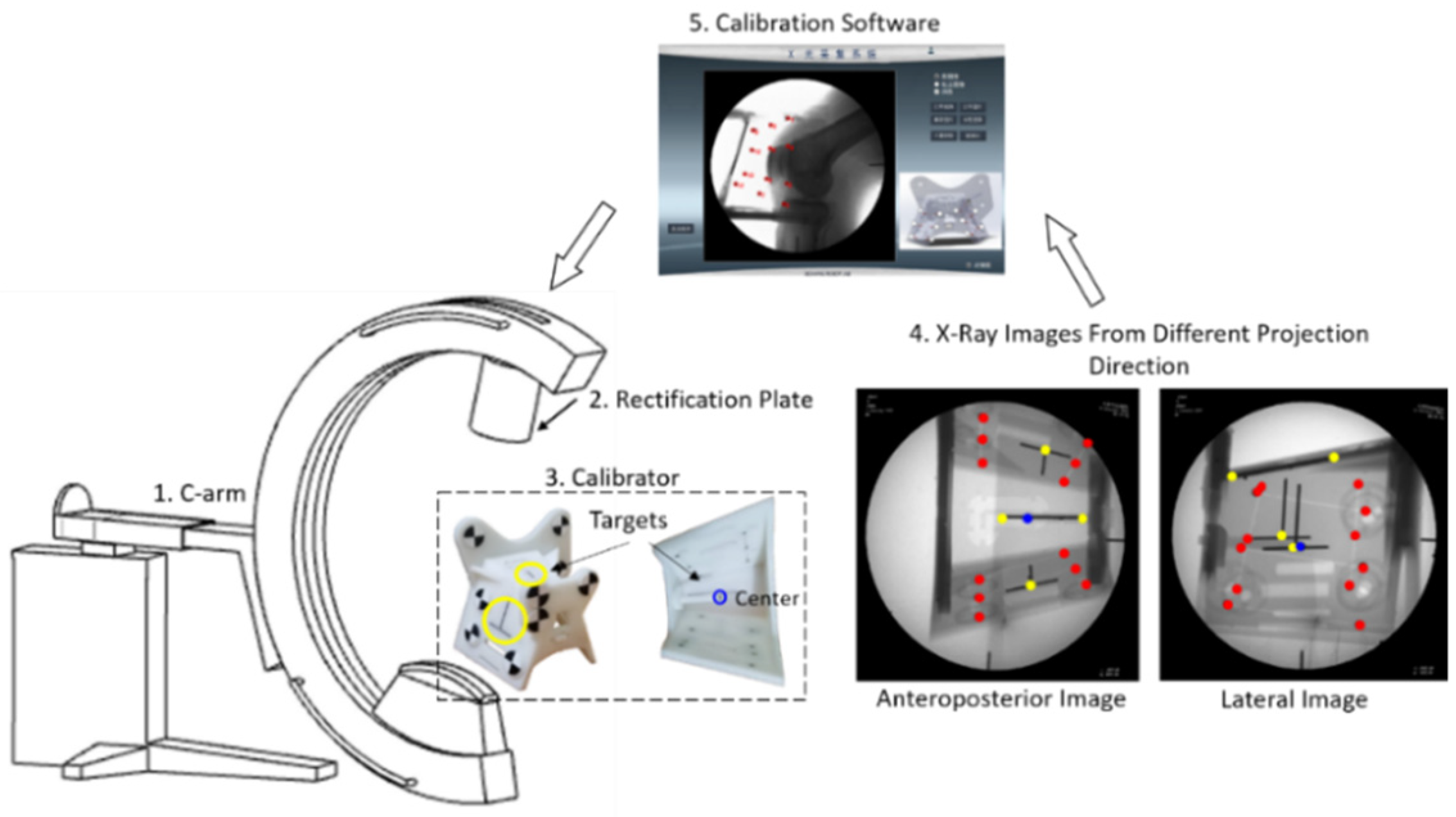


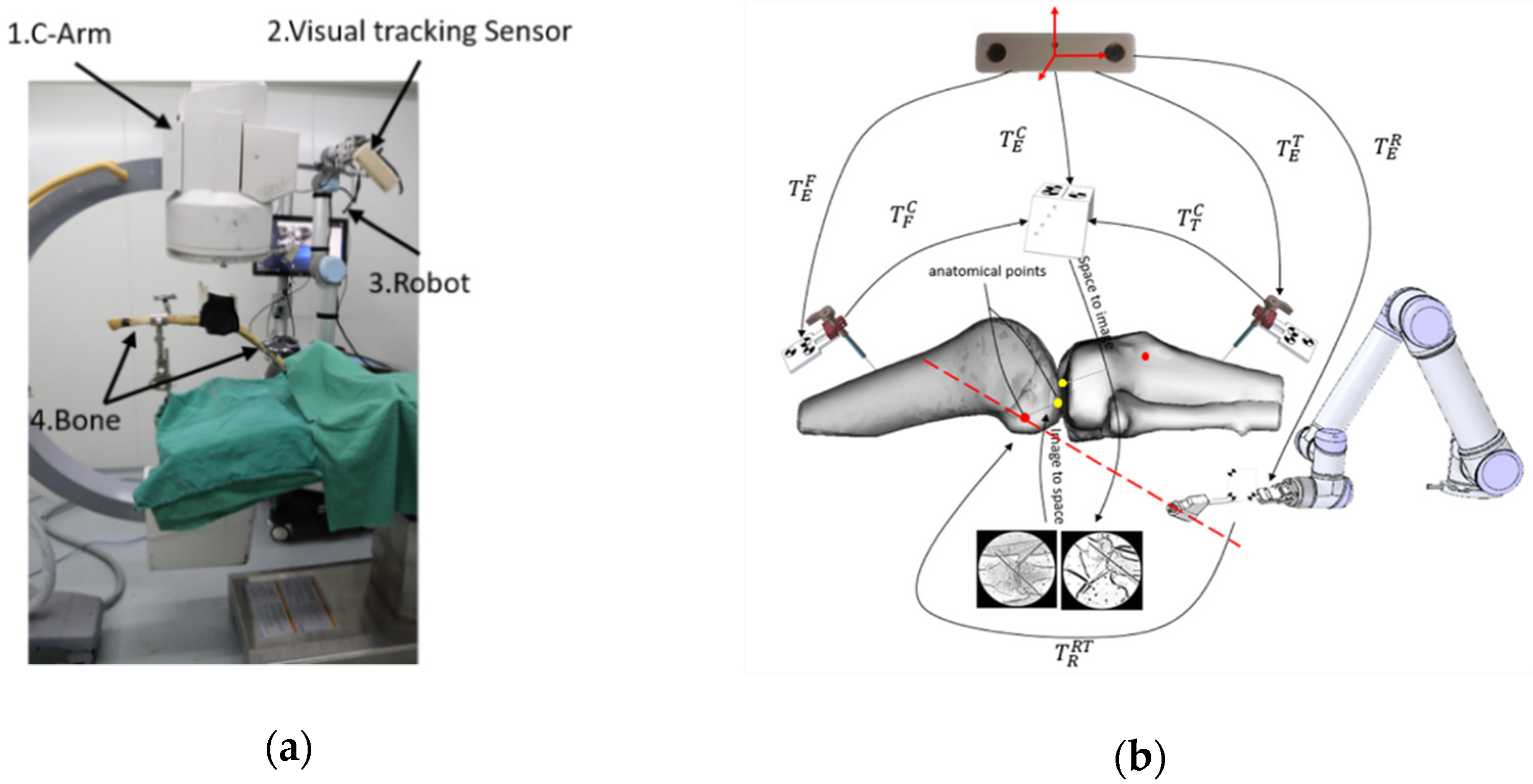

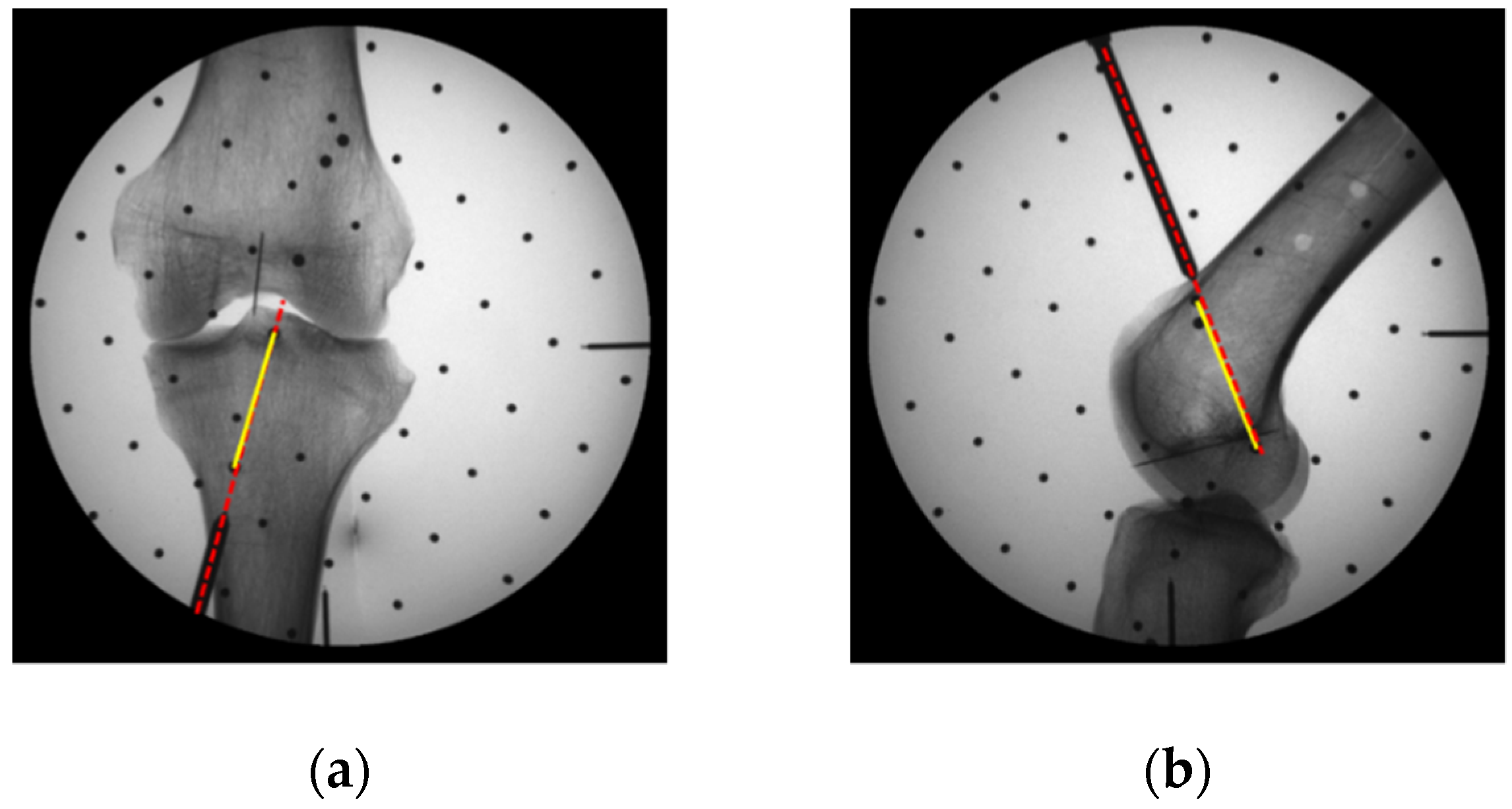
| Error (mm) | UDCSC Calibrator | Biplane Calibrator | |||||||
|---|---|---|---|---|---|---|---|---|---|
| Max | Min | Mean | RMS | Max | Min | Mean | RMS | ||
| FRE | 0.70 | 0.05 | 0.36 | 0.43 | 0.58 | 0.03 | 0.25 | 0.32 | |
| TRE | Points on Biplane | 7.53 | 3.30 | 4.50 | 4.68 | 0.89 | 0.20 | 0.58 | 0.65 |
| Center of UDCSC | 0.42 | 0.18 | 0.30 | 0.42 | 3.08 | 1.75 | 2.65 | 2.77 | |
| Points on UDCSC | 1.15 | 0.16 | 0.54 | 0.62 | 3.33 | 1.43 | 2.04 | 2.16 | |
| Positioning Errors (mm) | Start Points | End Points |
|---|---|---|
| Max | 1.55 | 1.89 |
| Min | 0.34 | 0.19 |
| Mean | 0.81 | 0.88 |
| RMS | 0.45 | 0.55 |
© 2019 by the authors. Licensee MDPI, Basel, Switzerland. This article is an open access article distributed under the terms and conditions of the Creative Commons Attribution (CC BY) license (http://creativecommons.org/licenses/by/4.0/).
Share and Cite
Guo, N.; Yang, B.; Wang, Y.; Liu, H.; Hu, L.; Wang, T. New Calibrator with Points Distributed Conical Helically for Online Calibration of C-Arm. Sensors 2019, 19, 1989. https://doi.org/10.3390/s19091989
Guo N, Yang B, Wang Y, Liu H, Hu L, Wang T. New Calibrator with Points Distributed Conical Helically for Online Calibration of C-Arm. Sensors. 2019; 19(9):1989. https://doi.org/10.3390/s19091989
Chicago/Turabian StyleGuo, Na, Biao Yang, Yuhan Wang, Hongsheng Liu, Lei Hu, and Tianmiao Wang. 2019. "New Calibrator with Points Distributed Conical Helically for Online Calibration of C-Arm" Sensors 19, no. 9: 1989. https://doi.org/10.3390/s19091989





